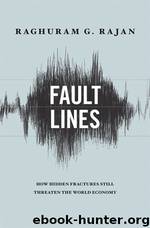Fault Lines: How Hidden Fractures Still Threaten the World Economy by Rajan Raghuram G

Author:Rajan, Raghuram G. [Rajan, Raghuram G.]
Language: eng
Format: epub
Tags: Business
ISBN: 9780691146836
Barnesnoble:
Goodreads: 7184066
Publisher: Princeton University Press
Published: 2010-05-24T00:00:00+00:00
Assigning Blame
The private financial sector bears an enormous responsibility for what happened. But did the brokers act immorally? Clearly, misleading retirees about their payments was wrong and bordered on the illegal. But although these are the cases that still make the headlines, it is not obvious that predatory lending of that sort was the norm. Brokers and firms like New Century provided many a homeowner with what they were asking for: refinancing at low rates, with little thought for the future. Should the broker have counseled the debt-ridden homeowners they were working with to cut back on consumption, pay off credit card debts, and move to a smaller, more affordable house? Perhaps some would have done so had they thought they would see their clients again. Knowing, however, that the mortgages they originated would be packaged and sold, they had little stake in the relationship, other than the fees—fees that indicated to them they were doing God’s work. Arm’s-length transactions do not foster empathy or a long-term focus.
There is, however, another check on arm’s-length transactions—a well-functioning competitive market. If New Century had been forced to sell its originations for fair value, it would never have originated the risky mortgages it did or put so many borrowers into unaffordable houses. The competitive market would have provided the mechanisms to keep First Century on track. Somehow, and unfortunately, the market was willing to pay much higher values for these mortgages than they were worth and did not exercise its customary discipline.
One reason might be that the market was irrationally exuberant and believed the poppycock that house prices would never go down. There is, however, mounting evidence that much of the boom and bust was concentrated in low-income housing, suggesting that this was not generalized irrationality and that other factors may have been at play.13
A more plausible argument is that the strong government push for home ownership by lower-income households led to an enormous increase in the volume of money poured into this sector. The brokers, lenders, packagers, and rating agencies simply did not have the personnel or capacity to manage the enormous workloads effectively. Although they may have worried about potential damage to their reputation from the slipshod work they were doing, the enormous fees they generated apparently allayed those worries.14 For example, many of New Century’s senior managers were industry veterans who knew they had the license to print money only for a limited time: even as New Century’s liquid assets fell in the period 2005–2007, as it was forced to absorb losses on loans it had to take back on its books, its dividends per share increased.15
This is not a complete argument, for it only kicks the conundrum one step down the road. It explains why the investment banks (and rating agencies) acted as boosters for New Century’s faulty mortgages, but not why they could sell them to others at a hefty premium. Either the final buyers were fooled by ratings or there was strong demand for these originations, without much thought to underlying price or quality.
Download
This site does not store any files on its server. We only index and link to content provided by other sites. Please contact the content providers to delete copyright contents if any and email us, we'll remove relevant links or contents immediately.
International Integration of the Brazilian Economy by Elias C. Grivoyannis(75552)
The Radium Girls by Kate Moore(11627)
Turbulence by E. J. Noyes(7708)
Nudge - Improving Decisions about Health, Wealth, and Happiness by Thaler Sunstein(7255)
The Black Swan by Nassim Nicholas Taleb(6775)
Rich Dad Poor Dad by Robert T. Kiyosaki(6186)
Pioneering Portfolio Management by David F. Swensen(6084)
Man-made Catastrophes and Risk Information Concealment by Dmitry Chernov & Didier Sornette(5659)
Zero to One by Peter Thiel(5498)
Secrecy World by Jake Bernstein(4395)
Millionaire: The Philanderer, Gambler, and Duelist Who Invented Modern Finance by Janet Gleeson(4108)
The Age of Surveillance Capitalism by Shoshana Zuboff(3991)
Skin in the Game by Nassim Nicholas Taleb(3973)
The Money Culture by Michael Lewis(3851)
Bullshit Jobs by David Graeber(3837)
Skin in the Game: Hidden Asymmetries in Daily Life by Nassim Nicholas Taleb(3731)
The Dhandho Investor by Mohnish Pabrai(3566)
The Wisdom of Finance by Mihir Desai(3532)
Blockchain Basics by Daniel Drescher(3333)
